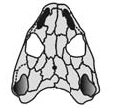Biology:Ecolsonia
| Ecolsonia | |
|---|---|

| |
| Ecolsonia Skull | |
| Scientific classification | |
| Domain: | Eukaryota |
| Kingdom: | Animalia |
| Phylum: | Chordata |
| Class: | Amphibia |
| Order: | †Temnospondyli |
| Family: | †Trematopidae |
| Genus: | †Ecolsonia Vaughn, 1969 |
Ecolsonia is an extinct genus of trematopid temnospondyl. Its phylogenetic position within Olsoniformes has been historically debated,[1][2] but it is presently considered to be a trematopid.[3][4]
History of study
The holotype of Ecolsonia is a partial skull that was collected in 1963 from the VanderHoof quarry in the Early Permian Cutler Formation of New Mexico.[1] The specimen was originally reposited at the now defunct University of California, Los Angeles Vertebrate Paleontology collections. The genus name is for the American paleontologist Everett C. Olson, and the species name is for the geologic provenance. A number of more complete specimens from the Morfin quarry in the Cutler Formation were discovered in 1983 and described by Berman et al. (1985), including a complete skull and large amounts of postcranial material. These specimens are currently reposited at the Carnegie Museum of Natural History.
Anatomy
Schoch & Milner (2014) listed seven features in the diagnosis of Ecolsonia: (1) tabular and squamosal frame otic fenestra; (2) prefrontal and postfrontal separated (shared with most other trematopids); (3) preorbital region of equal length to posterior skull table; (4) vomer with a posteromedial process meeting the pterygoid (shared with other trematopids); (5) a supratemporal that is twice as long as it is wide; (6) triangular patch of denticles on the parasphenoid (shared with other trematopids); and (7) basipterygoid region unsutured (shared with some other trematopids).[4] Trematopid synapomorphies include the posterior process of the vomer, the denticles on the parasphenoid, and the supinator process of the humerus. A large number of small scales were also found with some specimens of Ecolsonia that probably covered the entire body, a feature similar to that seen in the trematopid Anconastes; these are distinct from the osteoderms of dissorophids that are only associated with the vertebral column.
Relationships
Ecolsonia was originally classified as a trematopid by Vaughn (1969). At this time, only one other currently recognized trematopid was known (Acheloma and its junior synonym Trematops), in comparison to 13 known dissorophids, but Vaughn noted that the proportions of the skull, the sutural patterns, and the elongate naris were all features similar to those of Acheloma. Berman et al. (1985) classified Ecolsonia as a dissorophid in part because features considered to be diagnostic of trematopids were also found in other taxa interpreted as dissorophids, Actiobates peabodyi (now a trematopid) and Longiscitula houghae (now a junior synonym of the dissorophid Dissorophus multicinctus). In general, these authors considered many of the features that now link Ecolsonia to trematopids to be convergences acquired independently in dissorophids, a hypothesis that is no longer widely accepted or supported by phylogenetic analyses.[3][5][6]
References
- ↑ 1.0 1.1 Vaughn, Peter P. (1969). "Further evidence of close relationship of the trematopsid and dissorophid labyrinthodont amphibians with a description of a new genus and new species". Bulletin of the Southern California Academy of Sciences 68: 121–130.
- ↑ Berman, David S.; Reisz, Robert R.; Eberth, David A. (1985). "Ecolsonia cutlerensis, an early Permian dissorophid amphibian from the Cutler Formation of north-central New Mexico.". New Mexico Bureau of Mines and Minerals Research Circular 191: 1–31.
- ↑ 3.0 3.1 Polley, B.P.; Reisz, R.R. (2011). "A new Lower Permian trematopid (Temnospondyli: Dissorophoidea) from Richards Spur, Oklahoma". Zoological Journal of the Linnean Society 161 (4): 789–815. doi:10.1111/j.1096-3642.2010.00668.x.
- ↑ 4.0 4.1 Schoch, Rainer R.; Milner, Andrew R. (2014). Sues, Hans-Dieter. ed. Handbuch der Paläoherpetologie Part 3A2. Temnospondyli I.. Stuttgart: Verlag Dr. Friedrich Pfeil. ISBN 9783931516260. OCLC 580976.
- ↑ Berman, David S.; Henrici, Amy C.; Brezinski, David K.; Kollar, Albert D. (2009). "A New Trematopid Amphibian (Temnospondyli: Dissorophoidea) from the Upper Pennsylvanian of Western Pennsylvania: Earliest Record of Terrestrial Vertebrates Responding to a Warmer, Drier Climate" (in en). Annals of Carnegie Museum 78 (4): 289–318. doi:10.2992/007.078.0401. ISSN 0097-4463.
- ↑ Thuy, Ben, ed (2019-03-22). "Braincase simplification and the origin of lissamphibians". PLOS ONE 14 (3): e0213694. doi:10.1371/journal.pone.0213694. PMID 30901341.
Wikidata ☰ Q5333307 entry
 |

